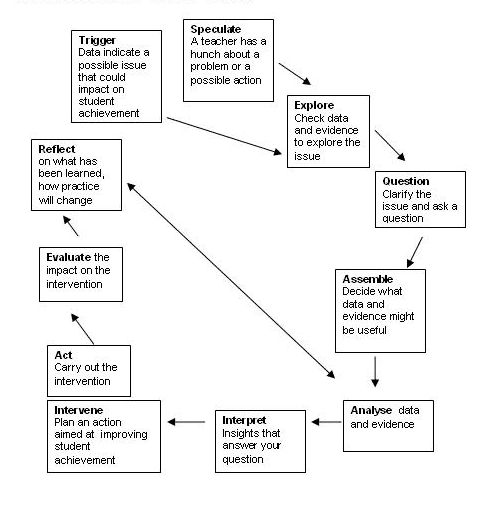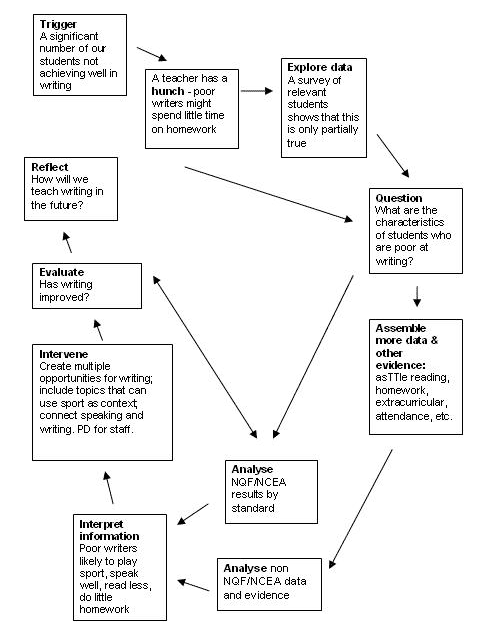You are here:
- Home »
- Using evidence for learning »
- Gathering evidence »
- The evidence-driven decision making cycle
Consider the evidence: The evidence-driven decision making cycle
- How to use this resource
- Introduction – Evidence-driven decision making
- What is meant by "data and other evidence"
- What evidence does a school have?
- What can we do with evidence?
- Evidence-driven strategic planning
- The evidence-driven decision making cycle
- Evaluation and reflection
- Types of analysis
- Terminology
- Resources
Steps in the evidence-driven decision making cycle
It’s useful to think of an evidence-driven decision-making cycle as having sequential steps.
Here we explain and discuss each step in turn. To find out more specific detail about each of these steps go to the "Read more" links.
| Trigger | Clues found in data, hunches |
| Explore | Is there really an issue? |
| Question | What do you want to know? |
| Assemble | Get all useful evidence together |
| Analyse | Process data and other evidence |
| Interpret | What information do you have? |
| Intervene | Design and carry out action |
| Evaluate | What was the impact? |
| Reflect | What will we change? |
The PowerPoint presentations attached to these web pages present these nine steps as three stages:
Getting started – the first stage of the process
Trigger
The trigger is whatever it is that makes you think there could be an opportunity to improve student achievement. Data, ideas, hunches, suspicions, observation, etc set a process in action. You can routinely scan available data looking for inconsistencies, patterns, or trends. It can be useful to speculate about possible causes or effects – and then explore data and other evidence to see if there are any grounds for the speculation. Read more »
Explore
Initial ideas or hunches usually need some preliminary exploration to pinpoint the issue and suggest good questions to ask. Read more »
Question
This is the key point: what question/s do you want answered? Questions can raise an issue and/or propose a possible solution. Read more »
Getting to information – the middle stage of the process
Assemble
Get together all the data and evidence you might need – some will already exist and some will have to be generated for the occasion. Read more »
Analyse
Process sets of data and relate them to other evidence. You are looking for trends and results that will answer your questions (but watch out for unexpected results that might suggest a new question). Read more »
Interpret
Think about the results of the analysis and clarify the knowledge and insights you think you have gained. Interrogate the information. It’s important to look at the information critically. Was the data valid and reliable enough to lead you to firm conclusions? Do the results really mean what they seem to mean? How sure are you about the outcome? What aspects of the information could lead to possible action? Read more »
Changing and evaluating – the final stage of the process
Intervene
Design and implement a plan of action designed to change the situation you started with. Be sure that your actions are manageable. Look at the resourcing needed. Consider how you’ll know what has been achieved. Read more »
Evaluate
Using measures you decided in advance, assess how successful the intervention has been. Has the situation that triggered the process been improved? What else happened that you maybe didn’t expect? Read more »
Reflect
Think about what has been learned and discovered. What did you do that worked? Did this process suggest anything that you need to investigate further? What aspects of the intervention can be embedded in practice and maintained? What support will you need? Read more »
The evidence-driven decision making cycle
The process can be seen as a cycle:

The length of the cycle will vary for different situations. You might wait a year to evaluate the effects of your actions – but sometimes you’ll be able to (and ought to) work to shorter (or maybe longer) cycles.
Download the text version of this diagram.
An example of evidence-driven decision making

This example demonstrates the how important it is to reflect, evaluate, and make professional judgments at every stage of the cycle.
Download the text version of this diagram.

